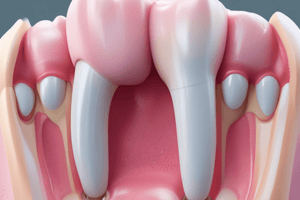Podcast
Questions and Answers
What is the primary purpose of using TheraCal, Biodentine, and MTA in pulp capping?
What is the primary purpose of using TheraCal, Biodentine, and MTA in pulp capping?
To repair and preserve the pulp
In which type of procedure is Biodentine and MTA commonly used?
In which type of procedure is Biodentine and MTA commonly used?
Apexification and retrograde filling
What is the ranking of biocompatibility among the three materials?
What is the ranking of biocompatibility among the three materials?
Biodentine and MTA > TheraCal
What type of cements are TheraCal, Biodentine, and MTA classified as?
What type of cements are TheraCal, Biodentine, and MTA classified as?
In which specific area of the tooth is TheraCal, Biodentine, and MTA used?
In which specific area of the tooth is TheraCal, Biodentine, and MTA used?
What is the main difference between Biodentine and MTA in terms of their applications?
What is the main difference between Biodentine and MTA in terms of their applications?
What is the primary advantage of using calcium silicate-based cements in endodontic procedures?
What is the primary advantage of using calcium silicate-based cements in endodontic procedures?
Flashcards are hidden until you start studying
Study Notes
Pulp Capping Materials
- TheraCal, Biodentine, and MTA are used in pulp capping to protect the pulp from bacteria and seal the exposure.
- Biodentine and MTA are often used in direct pulp capping and indirect pulp capping procedures.
- MTA (Mineral Trioxide Aggregate) is considered the most biocompatible material, followed by Biodentine, and then TheraCal.
- TheraCal, Biodentine, and MTA are classified as calcium silicate-based cements.
- These materials are used in the pulp chamber of the tooth.
- Biodentine is typically used in direct pulp capping, while MTA is more commonly used in indirect pulp capping and perforation repair.
- Calcium silicate-based cements promote biocompatibility and dentinogenesis, leading to better pulp healing and reduced risk of complications.
Studying That Suits You
Use AI to generate personalized quizzes and flashcards to suit your learning preferences.




